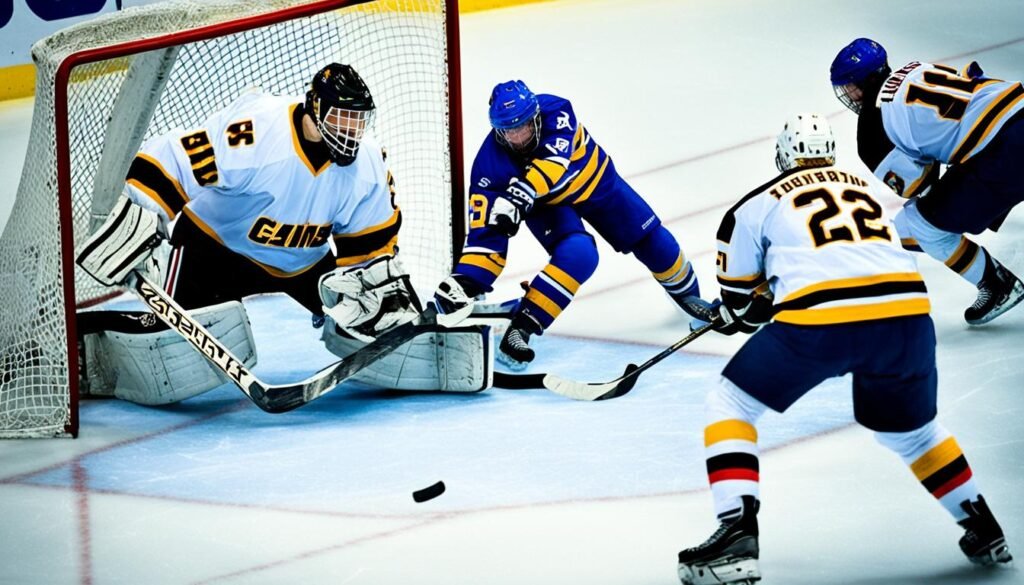In the sport of hockey, understanding the numbers behind the game is essential for gaining insights into player performance and team strategies. Hockey stats provide valuable information that helps coaches, analysts, and fans make well-informed assessments. In this article, I will break down the world of hockey analytics and explain the significance of different statistics in unraveling the game’s numbers.
Hockey Stats Explained
- Hockey stats offer valuable insights into player and team performance.
- Understanding stats like shots on goal and shooting percentage can help evaluate offensive effectiveness.
- Goalie statistics, such as save percentage, play a crucial role in evaluating a team’s defensive performance.
- Examining shot types and their impact provides insights into offensive pressure and defensive strategies.
- Tracking unique situations and exceptions in shot tracking adds complexity to interpreting hockey stats.
The Importance of Shots on Goal (SOG) in Hockey
In the fast-paced game of hockey, shots on goal (SOG) hold significant value for teams and players alike. SOG is a crucial statistic that gauges the number of shots attempted by a team or an individual that are on target and either stopped by the opposing goalie or go beyond the goal line. It serves as a key barometer for evaluating offensive performance and emphasizes a team’s ability to generate scoring opportunities.
The SOG statistic is prominently displayed on the scoreboard during games, reflecting its importance in the sport. Furthermore, it is documented in the official game summary, making it readily accessible for analysis and comparison. Understanding the significance of SOG in hockey is paramount for comprehending a team’s offensive tactics and assessing a player’s shooting effectiveness.
To illustrate the essence of shots on goal, consider the following scenarios:
- A player unleashes a powerful slap shot that the goalie skillfully blocks, demonstrating the goalie’s prowess in stopping shots on goal.
- An accurate wrist shot glides past the goalie’s outstretched glove and hits the back of the net, exemplifying the offensive player’s skill in converting a shot on goal into a goal.
- A well-executed one-timer shot from a teammate’s pass strikes the post and deflects away from the goal, highlighting the precision and accuracy required to generate shots on goal.
To better understand the impact of SOG, let’s examine a hypothetical example involving two teams:
| Team | Shots on Goal (SOG) | Goals Scored | Shooting Percentage |
|---|---|---|---|
| Team A | 30 | 3 | 10% |
| Team B | 40 | 4 | 10% |
In this example, both teams have a shooting percentage of 10%, indicating a similar level of shooting accuracy. However, Team B has a higher number of shots on goal (40) compared to Team A (30), resulting in a greater number of goals scored. This highlights the significance of generating a higher volume of shots on goal to increase the likelihood of scoring.
By focusing on shots on goal, teams can assess their offensive performance, identify areas for improvement, and adjust their strategies accordingly. Coaches and analysts can utilize this metric to evaluate the effectiveness of different offensive plays, line combinations, and shooting techniques. Additionally, tracking shots on goal over time provides valuable insights into a player’s development, shooting proficiency, and contribution to their team’s success.
Analyzing Shooting Percentage and its Relationship to SOG
Shooting percentage is a critical metric in hockey that provides valuable insights into a player’s scoring efficiency. It measures the percentage of shots taken that result in goals, indicating a player’s ability to convert their attempts into successful scoring opportunities. To calculate shooting percentage, simply divide the number of goals scored by the total number of shots taken.
Shooting percentage = (Goals Scored / Total Shots Taken) x 100
By analyzing shooting percentage in conjunction with shots on goal (SOG), we can gain a comprehensive understanding of a player’s offensive impact. SOG represents the number of shots that are on target and pose a challenge for the goaltender to stop. It is an essential statistic for evaluating offensive performance and can reflect a team’s ability to generate scoring opportunities.

A higher shooting percentage indicates a higher level of accuracy and scoring prowess, as a larger proportion of shots are resulting in goals. On the other hand, a lower shooting percentage may suggest the need for improvement in finishing skills or shot selection. It is vital to note that shooting percentage isn’t solely dependent on a player’s skill but also influenced by factors such as the quality of opposing goaltenders and the player’s role within the team.
Let’s take a look at an example to illustrate the impact of shooting percentage:
| Player | Goals Scored | Total Shots Taken | Shooting Percentage |
|---|---|---|---|
| Alex Ovechkin | 48 | 250 | 19.2% |
| Joe Schmo | 15 | 150 | 10.0% |
In the example above, Alex Ovechkin has a shooting percentage of 19.2%, indicating a high level of scoring efficiency. On the other hand, Joe Schmo has a shooting percentage of 10.0%, suggesting room for improvement in converting his shots into goals. Analyzing shooting percentage and its relationship to SOG can help teams and analysts assess a player’s offensive contribution and make strategic decisions.
In summary, shooting percentage is a valuable statistic in hockey that provides insights into a player’s scoring efficiency. By evaluating shooting percentage in conjunction with SOG, we can gauge a player’s ability to convert shots into goals and assess their offensive impact. Understanding the relationship between shooting percentage and SOG is vital for analyzing player performance and making informed decisions in the game of hockey.
Goalie Statistics and Shot Stopping Abilities
When evaluating a team’s defensive performance in hockey, goalie statistics play a crucial role. One key metric is shots against, which reflects the total number of shots faced by a goalie throughout a season. This statistic provides valuable insights into the workload of the goalie and the team’s ability to limit opponents’ scoring opportunities.
Another important metric in analyzing goalie performance is save percentage. Save percentage measures the percentage of shots stopped by the goalie out of the total shots faced. It is calculated by dividing the number of saves by the number of shots against.
Save percentage is a significant indicator of a goalie’s shot-stopping abilities and overall performance. A higher save percentage signifies a goalie’s proficiency in stopping shots, while a lower save percentage may indicate the need for improvement.
Goalie Statistics
| Stat Category | Definition |
|---|---|
| Shots Against | The total number of shots faced by a goalie throughout a season. |
| Save Percentage | The percentage of shots stopped by the goalie out of the total shots faced. Calculated by dividing the number of saves by the number of shots against. |
Understanding and analyzing these goalie statistics can provide valuable insights into a team’s defensive abilities and the individual performance of the goalie.
Understanding Different Types of Shots and Their Impact
In addition to shots on goal, there are various types of shots in hockey that contribute to a team’s offensive strategy. These different types of shots can have a significant impact on the game, providing insights into a team’s offensive pressure and defensive strategies. Let’s explore some of the key types of shots in hockey and their importance.
Tip-ins and Redirections
One type of shot that can lead to goals is the tip-in or redirection. This occurs when a player redirects a teammate’s shot into the net. These shots are counted as shots on goal and can often catch the goalie off guard, making them difficult to save. Tip-ins and redirections require excellent hand-eye coordination and timing, and they play a crucial role in a team’s offensive strategy.
Penalty Shots and Shootout Attempts
Penalty shots and shootout attempts are additional types of shots in hockey that are recorded as shots on goal. Penalty shots are awarded when a player is obstructed or fouled on a clear scoring opportunity. Shootout attempts occur during a tied game at the end of overtime and involve one player taking a shot against the opposing goalie. Although these shots do not factor into a player’s or goalie’s career statistics, they can have a significant impact on the outcome of a game.
Shot Blocking by Defenders
While shots on goal measure the number of shots that reach the net, it is essential to consider all shot attempts, including those blocked by defenders. Shot blocking is a fundamental defensive skill in hockey, and it plays a crucial role in disrupting the opposing team’s offense. Blocked shots can prevent goals and demonstrate a team’s commitment to defensive play. Analyzing shot attempts, including those blocked by defenders, provides insights into a team’s defensive strategies and the effectiveness of their shot-blocking techniques.
Understanding the different types of shots in hockey and their impact is key to analyzing the game and evaluating a team’s offensive and defensive strategies.
Unique Situations and Exceptions in Shot Tracking
Tracking shots on goal in hockey can present unique situations and exceptions that affect the accuracy of the statistics. These scenarios include own goals, empty net goals, and shots blocked by defenders.
Own Goals
An own goal occurs when a player unintentionally shoots the puck into their own team’s net, resulting in a goal for the opposing team. Despite the inadvertent nature of these goals, they are still credited as both a goal and a shot on goal for the opposing team. This is an exception to the traditional definition of shots on goal, as the player shooting the puck did not intend to score for their own team.
Empty Net Goals
In certain situations, a hockey team may decide to pull their goalie in favor of an extra attacker, creating an empty net. During this time, any goal scored by the team with the empty net is automatically awarded, even if there was no official shot taken. While these goals may not be recorded as shots on goal, they still count towards the team’s overall score.
Shot Blocking
Shot blocking is a crucial defensive tactic employed by players to prevent the opposing team from getting shots on goal. When a shot is blocked by a defender, it is counted as a shot attempt but does not count as a shot on goal. This distinction is important when analyzing team defensive strategies and evaluating the effectiveness of shot-blocking players.

The Role of Hockey Stats in Game Analysis and Player Evaluation
Hockey stats play a vital role in analyzing games and evaluating players’ performances. By utilizing various metrics such as shots on goal, shooting percentage, and save percentage, coaches, analysts, and fans can gain valuable insights into team strategies and individual contributions. These stats serve as powerful tools to identify strengths and weaknesses, make informed decisions, and track player development over time.
When it comes to game analysis, hockey stats provide a comprehensive overview of a team’s performance. Shots on goal, for example, indicate the frequency and quality of scoring opportunities generated. A high number of shots on goal suggests an offensive mindset and the ability to create high-percentage chances. On the other hand, a low number of shots on goal may indicate a lack of offensive pressure or struggles to generate scoring opportunities.
Additionally, shooting percentage offers insights into a player’s efficiency in converting shots into goals. A high shooting percentage indicates a player’s ability to capitalize on scoring chances, while a low shooting percentage may suggest a need for improvement in finishing skills. This metric helps assess a player’s offensive contribution and can guide strategic decisions related to line combinations and power play units.
Save percentage is a crucial stat used to evaluate goaltenders’ performances. It represents the percentage of shots stopped by a goalie out of the total shots faced. A high save percentage indicates strong shot-stopping abilities and consistent performance, while a low save percentage may highlight weaknesses or inconsistencies in a goalie’s game. Analyzing this stat helps coaches and management make informed decisions about goaltending rotations and potential acquisitions.
Player evaluation is another area where hockey stats prove indispensable. Coaches and scouts utilize a wide range of metrics to assess players’ performances and potential. Studying individual stats can help identify players with strong offensive or defensive contributions, highlight their strengths and weaknesses, and compare them to their peers. With the help of stats, talent evaluation becomes more objective and data-driven.
Understanding and utilizing hockey stats are essential skills for anyone involved in the game. These stats provide valuable insights into game strategies, player performance, and team dynamics. By analyzing and interpreting the numbers, stakeholders in the hockey world can make more informed decisions, optimize game plans, and foster player development.
Conclusion
Understanding hockey statistics is essential for unraveling the game’s numbers and gaining valuable insights into player and team performance. Through metrics such as shots on goal, shooting percentage, and save percentage, we can analyze and interpret NHL data to comprehend the strategies and skills utilized in the game.
By delving into hockey stats, we develop a deeper appreciation for the nuances of the sport. These statistics provide a comprehensive understanding of player abilities, team tactics, and overall performance. From evaluating offensive contributions through shots on goal and shooting percentage to assessing a goalie’s shot-stopping abilities through save percentage, these metrics paint a vivid picture of the intricacies of the game.
Whether for game analysis, player evaluation, or pure enjoyment, hockey stats offer valuable insights. They form the foundation for making informed assessments and strategic decisions. So, let’s embrace the world of hockey statistics and uncover the hidden stories behind the numbers, enabling us to fully comprehend the game of hockey.







